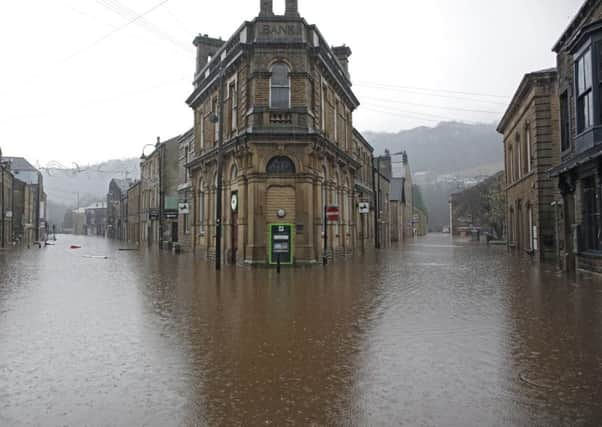Flooding cash is '˜biased towards the South'


The Government has said it applies a strict economic formula to deciding where funding should be spent.
But an investigation by the Press Association reveals the methods to determine where funding goes focuses on the value of assets protected - which could tilt the system towards richer households and those in parts of the country where house prices are higher.
Advertisement
Hide AdAdvertisement
Hide AdIt has prompted calls for a fairer system to prevent the poor being worst hit by flooding events, which are set to increase as the climate changes.
To secure funding, a flood protection scheme has to demonstrate that it delivers more in benefits than it costs to implement and maintain the defences - by calculating the economic losses avoided through protecting property and infrastructure.
The calculation looks at direct damages for homes and other buildings and their contents, clean-up costs, loss of agricultural production and commercial stock as well as indirect damages such as disruption to transport links, water, electricity or access to amenities.
To calculate losses from homes, properties are divided into 28 standard categories based on age, size and type, according to the Flood and Coastal Erosion Risk Management manual, which along with an online handbook advises appraisers on how to assess flood defence schemes.
Advertisement
Hide AdAdvertisement
Hide AdThe costs of a given level of flooding for larger properties - for example a detached Victorian house - are considered to be up to several times greater than for smaller homes such as a 1970s semi.
People who are in a higher social class, such as upper middle or middle class, in professional or managerial roles, are considered to have better quality household items than working class families, so losses from their properties are greater.
Treasury guidelines also require appraisers to “cap” or limit the value of the damages expected so they do not exceed the market value of the property - which is likely to be much higher in London and the South East than other parts of the country.
This means the losses from properties in the South East could be calculated as higher than elsewhere, making a flood defence scheme that protects those homes look more attractive.
Advertisement
Hide AdAdvertisement
Hide AdThe Flood and Coastal Erosion Risk Management manual says: “This capping at market values creates regional distribution issues (e.g. houses within the M25 are significantly more expensive than comparable houses in the north of England) for which there is, at present, no official counter-mechanism.”
The system does have measures to level the playing field, with a greater ratio of funding from Government for schemes that reduce flood risk for homes in deprived areas than in wealthier areas and ways in the appraisal to look at vulnerable households.
And analysis should be done where “necessary” or “practical” to give more weight to poorer households, according to Treasury guidelines.
But Green Party MP Caroline Lucas said it seemed the funding formula was not “fit for purpose”.
Advertisement
Hide AdAdvertisement
Hide Ad“Whether you are rich or poor having your home damaged by flooding is devastating - and a postcode lottery to decide who gets protection simply isn’t fair. It’s simply wrong for richer areas to get more protection than poorer ones.
“The Government should urgently review this policy, and re-purpose the formula to give equal protections to people’s homes, no matter what their value.
“With climate change accelerating and flooding expected to become a more regular occurrence it’s crucial that the Government gets this right.”
Friends of the Earth climate campaigner Guy Shrubsole said: “This is further evidence of how the poorest are hit hardest by floods - something that will only get worse as climate change worsens flooding.
Advertisement
Hide AdAdvertisement
Hide Ad“All communities at risk of flooding must be adequately defended. As climate change worsens extreme weather, communities have every right to press the Government for a fairer approach to protect their families, homes and livelihoods.”
An Environment Agency spokesman said: “We know the devastating impact that flooding has on lives and livelihoods.
“We invest in flood defences where the risk is highest, wherever it is across the country and wherever it will benefit the most people and property.
“We give each scheme careful consideration - and this includes additional weighting for regional economic differences.”
Advertisement
Hide AdAdvertisement
Hide AdCoun Tom Leadley, who chaired a scrutiny committee into flooding in Leeds in 2005, said the system was “arthritic - it doesn’t move fast enough.”
Kirkstall - which was badly flooded last year - would come out lower in the Government’s cost benefit analysis, because it had more commercial businesses which were rated lower than homes. He added: “There’s supposed to be a study going on in Kirkstall, but nothing is actually happening.” However he warned against a “North-South slanging match”: “There needs to be more money all round.”
Calderdale was the worst-hit in Yorkshire last year with 2,135 homes and 945 businesses flooded. Coun Robert Holden said local topography and the fact many affected properties were businesses with living space upstairs worked against them: “There should be a fairer system - it so frustrating for friends in the Environment Agency because the formula is so rigid. They’d like to see more flexibility in the way it is applied.”
Figures showing regional spend on flood defences for the period 2010-2015 and for the last financial year (2015/2016) are as follows:
:: East Midlands: £147,363,000, £18,473,000;
:: East of England: £241,787,000, £55,303,000;
:: London: £81,529,000, £14,412,000;
:: North East: £73,278,000, £12,571,000;
:: North West: £160,868,000, £42,728,000;
:: South East: £263,323,000, £58,709,000;
:: South West: £146,521,000, £27,669,000;
:: West Midlands: £27,396,000, £8,980,000;
:: Yorkshire and the Humber: £183,172,000, £43,868,000.